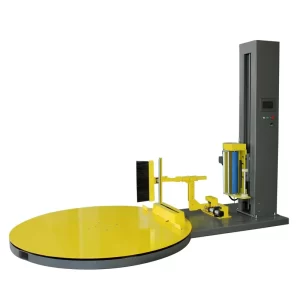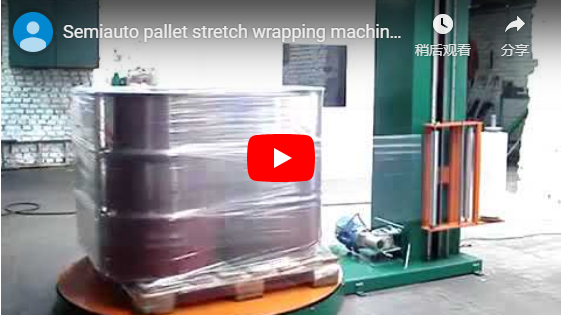Optimizing Load Containment: A Guide to the A100 Semi-Automatic Pallet Stretch Wrapper
Semi-automatic stretch wrapping machines play a crucial role in modern packaging and logistics, offering a significant step up from manual wrapping in terms of efficiency, consistency, and load security. Understanding the operation and capabilities of models like the A100 is key to maximizing these benefits in a warehouse or production environment. This guide delves into the technical aspects, operational procedures, and practical advantages of the A100 semi-automatic pallet stretch wrapper.
The video above demonstrates the A100 in a typical operational cycle, showcasing its core functionality in securing palletized loads.
1. A100 Technical Specifications and Key Features
Understanding the machine's parameters is essential for proper application and ensuring it meets specific operational needs. While exact specifications can vary slightly, typical features for a machine in this class include:
- Wrapping Mode: Semi-automatic operation (operator initiates cycle, attaches/cuts film).
- Turntable Diameter: Commonly around 1500mm to 1650mm, suitable for standard pallet sizes.
- Maximum Load Weight: Typically supports loads up to 1500kg - 2000kg.
- Maximum Wrapping Height: Often accommodates pallets up to 2100mm or 2400mm.
- Turntable Speed: Adjustable, usually ranging from 3 to 12 RPM, allowing control over wrap application speed.
- Film Carriage System: May feature mechanical or powered pre-stretch (e.g., up to 250%), which significantly reduces film consumption and improves load retention. Verify the specific pre-stretch capability of the unit.
- Control System: Often utilizes a PLC (Programmable Logic Controller) for reliability and allows adjustment of parameters like top/bottom wrap counts and turntable/carriage speed.
- Power Requirements: Check voltage and phase requirements (e.g., 220V/1Ph/50-60Hz or specific regional standards).
- Construction: Robust steel frame designed for industrial environments.

pallet stretch wrap 1 jpg 2. Step-by-Step Operation Guide
Operating the A100, like most semi-automatic wrappers, follows a straightforward process:
- Load Placement: Using a forklift or pallet jack, carefully place the palletized load in the center of the turntable. Ensure the load is stable before proceeding.
- Film Attachment: Pull out the stretch film from the film carriage and securely tie it to the base of the pallet or tuck it between layers of the load.
- Parameter Selection: Use the control panel to select the desired wrapping program or manually set parameters such as:
- Number of top wraps (secures the top of the load).
- Number of bottom wraps (reinforces the base).
- Turntable rotation speed.
- Film carriage ascent/descent speed (controls wrap overlap).
- Film tension/pre-stretch level (if adjustable).
- Initiate Cycle: Press the start button. The machine will automatically begin rotating the turntable and moving the film carriage up and down according to the selected parameters. Maintain a safe distance during operation.
- Cycle Completion: Once the wrapping cycle is finished, the machine will stop.
- Film Cut and Seal: Carefully cut the stretch film near the load. Wipe the film tail against the wrapped load; the cling property of the film will typically hold it in place.
- Unload: Remove the securely wrapped pallet from the turntable using a forklift or pallet jack.
3. Practical Advantages in Warehouse Operations
Implementing a semi-automatic wrapper like the A100 provides tangible benefits beyond simply covering a pallet:
- Improved Load Stability: Consistent wrap tension and placement significantly reduce the risk of product shifting or damage during handling and transit. This is crucial for maintaining product integrity and reducing costly returns.
- Increased Throughput: While not fully automatic, the A100 drastically speeds up the wrapping process compared to manual methods, freeing up operator time for other tasks. Wrapping a pallet typically takes only 1-2 minutes.
- Consistent Wrap Quality: Machine application ensures uniformity in wrapping that is difficult to achieve manually, leading to predictable load containment performance.
- Material Savings: Especially with powered pre-stretch systems, the film can be elongated effectively (e.g., 1 meter yields up to 3.5 meters), reducing overall film consumption per pallet compared to manual wrapping or machines without pre-stretch.
- Enhanced Ergonomics: Reduces the physical strain and repetitive motions associated with manual stretch wrapping, contributing to a safer work environment and reducing potential injuries.
4. Maintenance Essentials and Basic Troubleshooting
Regular maintenance ensures longevity and optimal performance:
- Daily Checks: Keep the area around the turntable clear of debris. Check film roll status. Visually inspect sensors and moving parts.
- Film Roll Changes: Follow manufacturer instructions for safely loading new film rolls, ensuring correct threading through the carriage and pre-stretch rollers (if applicable).
- Cleaning: Regularly clean photoelectric sensors that detect pallet height. Keep the film carriage rollers free from dirt and adhesive buildup.
- Lubrication: Adhere to the manufacturer's recommended lubrication schedule for bearings and chains.
- Common Issues:
- Film Breaks: Often caused by excessive tension, sharp corners on the load, or poor film quality. Adjust tension or consider corner protectors.
- Inconsistent Wrapping: Check sensor cleanliness, parameter settings, and film threading.
- Consult the Manual: Always refer to the specific A100 user manual for detailed maintenance procedures, troubleshooting guides, and safety precautions.
pallet stretch wrapping machine with weighing scale 5. Considerations for Selecting a Stretch Wrapper
While the A100 serves many general purposes, selecting the right machine involves evaluating:
- Wrapping Volume: Assess the number of pallets per day/shift. Higher volumes might justify a fully automatic system.
- Load Characteristics: Consider the weight, height, stability, and shape of typical loads. Irregular or very heavy loads may require specific machine features.
- Budget: Semi-automatic machines offer a balance between cost and performance compared to manual or fully automatic options.
- Space Availability: Ensure adequate floor space for the machine footprint and maneuvering room for loading/unloading.
- Feature Requirements: Determine the necessity of features like powered pre-stretch, specific control options, or integrated scales.
For more details on semi-automatic stretch wrapping solutions, you can explore options like the Semiauto pallet stretch wrapping machine A100. You can also find valuable information on packaging standards and best practices from industry resources like the Packaging Machinery Manufacturers Institute (PMMI).
Conclusion
The A100 semi-automatic pallet stretch wrapper represents a reliable and efficient solution for improving load containment in numerous industrial settings. By understanding its technical capabilities, adhering to proper operating procedures, and performing routine maintenance, businesses can leverage this technology to enhance packaging quality, increase operational speed, reduce material costs, and create a safer working environment. Its ease of use and consistent performance make it a valuable asset for optimizing logistics and protecting goods throughout the supply chain.


